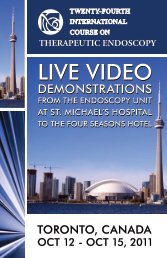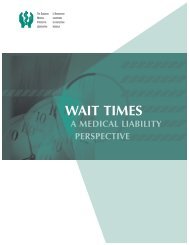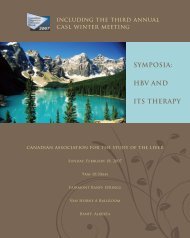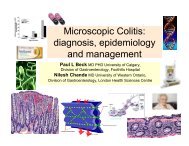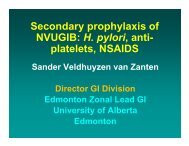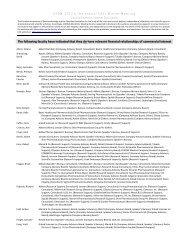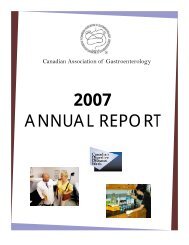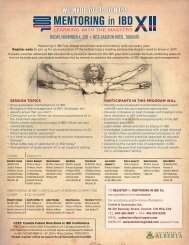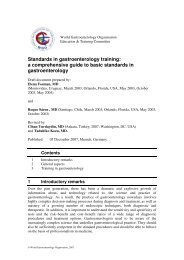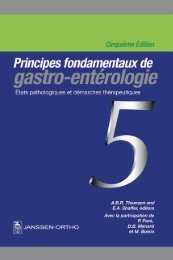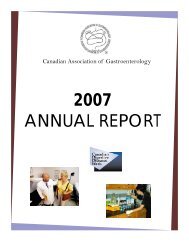Manifestations of Gastrointestinal Disease in the Child
Manifestations of Gastrointestinal Disease in the Child
Manifestations of Gastrointestinal Disease in the Child
You also want an ePaper? Increase the reach of your titles
YUMPU automatically turns print PDFs into web optimized ePapers that Google loves.
684 FIRST PRINCIPLES OF GASTROENTEROLOGY<br />
Genitour<strong>in</strong>ary and gastro<strong>in</strong>test<strong>in</strong>al disorders are <strong>the</strong> most common organic<br />
causes <strong>of</strong> chronic abdom<strong>in</strong>al pa<strong>in</strong>. Recurrent ur<strong>in</strong>ary tract <strong>in</strong>fection and<br />
hydronephrosis or obstructive uropathy can present with abdom<strong>in</strong>al pa<strong>in</strong>.<br />
Usually features <strong>in</strong> <strong>the</strong> history atypical for functional pa<strong>in</strong> and/or abnormal<br />
ur<strong>in</strong>alysis would suggest <strong>the</strong> diagnosis.<br />
Constipation is a common disorder and patients may experience crampy<br />
abdom<strong>in</strong>al discomfort <strong>in</strong> association with <strong>the</strong> urge to defecate. A suggestive<br />
history and <strong>the</strong> demonstration on physical exam<strong>in</strong>ation <strong>of</strong> bulky stool reta<strong>in</strong>ed<br />
<strong>in</strong> <strong>the</strong> rectum should <strong>in</strong>itiate a trial <strong>of</strong> appropriate treatment.<br />
A history <strong>of</strong> abdom<strong>in</strong>al pa<strong>in</strong>, bloat<strong>in</strong>g, flatus and watery diarrhea that<br />
occurs with heavy <strong>in</strong>gestion <strong>of</strong> “sugarless” gums or confections suggests <strong>the</strong><br />
possibility <strong>of</strong> malabsorption <strong>of</strong> nonabsorbable carbohydrates. The same<br />
history occurr<strong>in</strong>g with milk <strong>in</strong>take <strong>in</strong> <strong>in</strong>dividuals whose ethnic background<br />
might predispose to lactase deficiency (oriental, black or peri-Mediterranean)<br />
suggests lactose malabsorption.<br />
A history <strong>of</strong> frequent vomit<strong>in</strong>g or bilious vomit<strong>in</strong>g <strong>in</strong> <strong>the</strong> presence <strong>of</strong><br />
abdom<strong>in</strong>al pa<strong>in</strong> should be a “red flag” suggest<strong>in</strong>g <strong>the</strong> possibility <strong>of</strong> <strong>in</strong>test<strong>in</strong>al<br />
obstruction. Malrotation or <strong>in</strong>complete rotation <strong>of</strong> <strong>the</strong> mid-gut is a disorder<br />
that may present as a bowel obstruction and also predisposes to <strong>in</strong>test<strong>in</strong>al<br />
volvulus. Whenever malrotation is suspected an upper gastro<strong>in</strong>test<strong>in</strong>al series<br />
should be performed to determ<strong>in</strong>e <strong>the</strong> position <strong>of</strong> <strong>the</strong> duodenojejunal flexure,<br />
and a barium enema may be required to ensure proper location <strong>of</strong> <strong>the</strong> cecum<br />
<strong>in</strong> <strong>the</strong> lower right quadrant.<br />
Primary peptic ulcer disease is much less common <strong>in</strong> children than <strong>in</strong> adults<br />
and frequently lacks <strong>the</strong> typical meal-related characteristics that are common<br />
with <strong>the</strong> adult presentation. A family history <strong>of</strong> peptic ulcer disease, vomit<strong>in</strong>g,<br />
nighttime awaken<strong>in</strong>g with pa<strong>in</strong>, hematemesis or melena, or unexpla<strong>in</strong>ed<br />
anemia should suggest <strong>the</strong> diagnosis.<br />
1.5 Management<br />
To successfully manage <strong>the</strong> child, it is crucial <strong>the</strong> history and physical<br />
exam<strong>in</strong>ation are conducted with care and thoroughness. Such caution<br />
demonstrates <strong>the</strong> physician has seriously evaluated <strong>the</strong> compla<strong>in</strong>t. Once a<br />
diagnosis <strong>of</strong> functional abdom<strong>in</strong>al pa<strong>in</strong> has been made, it is important to<br />
cease <strong>in</strong>vestigations and to educate and reassure <strong>the</strong> patient and parents.<br />
It must be made clear that <strong>the</strong> discomfort <strong>of</strong> <strong>the</strong> recurrent abdom<strong>in</strong>al pa<strong>in</strong><br />
is genu<strong>in</strong>e, not imag<strong>in</strong>ed or manufactured for ga<strong>in</strong> or manipulation. It is<br />
important to po<strong>in</strong>t out that this is a common compla<strong>in</strong>t. Identify for <strong>the</strong><br />
parent those criteria upon which you based <strong>the</strong> diagnosis <strong>of</strong> <strong>the</strong> functional<br />
gastro<strong>in</strong>test<strong>in</strong>al disorder, for example with functional abdom<strong>in</strong>al pa<strong>in</strong><br />
syndrome: <strong>the</strong> periumbilical location <strong>of</strong> <strong>the</strong> discomfort, <strong>the</strong> absence <strong>of</strong> any<br />
constellation <strong>of</strong> historical or objective physical f<strong>in</strong>d<strong>in</strong>gs that suggest under-



